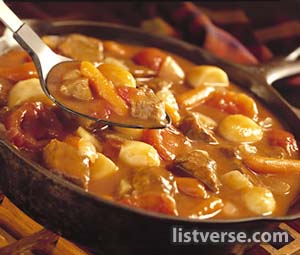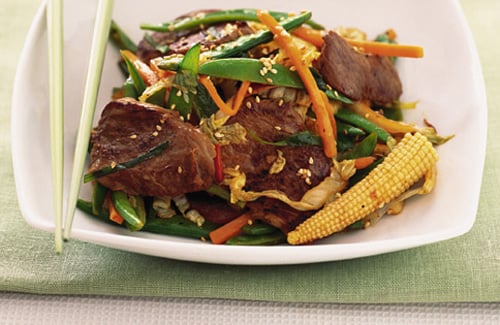Techniques for Cooking Meat
8 Techniques for Cooking Meat - a special request hub
There are many techniques for cooking meat: Braising, cooking in liquid, broiling, grilling, skillet cooking, stir frying, roasting and parboiling (before grilling) will be covered here.
I don't claim to be an expert but I have used all of these methods. If you are choosing a less-expensive cut of meat, you will need moist heat for cooking. The more tender cuts of meat will be best-cooked by dry heat. Let me explain.
For beef, the least expensive cuts are chuck steaks, chuck roasts and short ribs, round steaks, briskets and bottom round cuts.
For pork, the less-expensive cuts are ham hocks and spareribs.
For lamb, hind shanks, fore shanks and sometimes the blade chops.
When you cook the meats that are cheaper, a moist heat is preferred.

BRAISING
This method is used for the less expensive cuts of meat.
Turn your stove burner on medium-high heat. Let the pan heat up for 1-2 minutes. I usually use a skillet or Dutch oven. Lay your meat in the pan. You should hear a sizzle. Brown the meat on all sides. If it starts to burn, turn the heat down a little. Sometimes I use a tablespoon of olive oil, but it is not necessary because you are going to "de-glaze" the pan. I'll explain.
After the meat is browned on all sides, you can use liquid to finish the cooking. I like to use red wine (about a tablespoon at a time) to loosen those stuck-on bits on the bottom of the skillet. (De-glazing) The alcohol content evaporates. If you don't use wine, you can use water, beef broth, juice. (Apple juice is good with pork.)

COOKING IN LIQUID OR STEWING
Cooking in liquid is similar to braising. After browning the meat, more liquid is used. This will make a sauce or broth later. I usually add about a cup of liquid at a time. Vegetables can be added here. After the meat is cooked, the sauce can be thickened with cornstarch or flour to make a gravy. Some people just like to use the broth, as is, to pour over the meat later. You may want to add more liquid as it evaporates, so watch your pot.
TENDERIZING
Less tender cuts of meat can be tenderized before cooking.
1) Pounding - I remember my mother always used to pound the round steak or cubed steak before she cooked it. Use a meat mallet. Start at the center and pound the meat to the edges until thin.
2) Scoring - Use a sharp knife to make diagonal cuts in the meat (not too deep)
3) Marinating - Use a combination of something acidic like lemon juice, vinegar, wine or tomatoes over the meat. Then refrigerate for an hour or overnight. This will not only tenderize the meat but add flavor.
Asian-Flavored Marinade
Combine 1/4 cup low-sodium soy sauce or Tamari, 1 Tablespoon orange peel, 1/4 cup orange juice, 1 Tablespoon lemon peel, 3 Tablespoons lemon juice, 1 Tablespoon brown sugar, 2 teaspoons sesame oil and 3 cloves minced garlic. Pour over meat and refrigerate. You can turn the meat after 1/2 hour to marinate on other side.
4) Commercial meat tenderizer - You can buy tenderizer in the grocery store. It comes in a spice-type bottle and when I buy it, I try to get one that doesn't have MSG in it (Monosodium glutamate) because I am sensitive to it and sometimes get headaches.

Parboiling Before Grilling
Parboiling is simply pre-cooking the meat before you cook it! Make sense?
I like to parboil pork spareribs and beef country ribs before I bar-b-que them or grill them. Get a large Dutch oven and fill it about halfway with water. Bring to a boil. Carefully drop in your ribs and boil them for about 45 min to one hour.Then you can make your barbeque sauce while the ribs are cooking.
It's OK to bake them, covered, in a roasting pan for about an hour at 350 degrees instead. Then you can grill them with barbeque sauce for another 30 minutes.
Try both ways and see which way you prefer!
BROILING GUIDELINES FOR BEEF

BROILING
Now that I've explained how to cook less expensive meats, let's talk about the more tender cuts of meat.
Beef - rib eye steak, tenderloin steak, strip steak, T-bone or Porterhouse steak, top sirloin steak
Pork - Blade steak, top loin chops, butterfly chops, rib chops, smoked loin chops, bacon, center cut ham
Lamb - rib chops, arm chops, loin chops, blade chops, leg center slice
These can all be broiled. To broil, preheat your broiler. Place meat in a broiler pan. For thinner cuts, broil 3-4 inches from the heat. For thicker cuts, broil 4-5 inches from the heat.
GRILLING
I could write a hub all about grilling, but I'll just cover the basics. All of the steaks and chops you can broil, you can also grill. In addition, if you marinated or parboiled your cheaper cuts of meat, you can grill them as well.
Place the meat on the grill directly over medium heat. For charcoal grills, you can grill uncovered, turning once. For gas grills, preheat the grill, place meat on grill over medium heat and cover. Use a meat thermometer to check for doneness.
My father always cooked steaks on the grill and he always said 6 minutes on each side was perfect for a medium steak.
Here is a chart from sizzleonthe grill.com.

ROASTING
Beef - Bottom sirloin roast, eye round roast, ribeye roast, top round roast, round tip roast, tenderloin roast, rib roast
Lamb - Leg of lamb, shoulder roast, sirloin roast
Pork - Ham, sirloin roast, top loin roast, spareribs, country style ribs, crown roast smoked shoulder picnic ham
Place meat, fat side up, in a roasting pan. Do not cover nor add water or liquid. Insert a meat thermometer and roast at 325 degrees until the thermometer reaches the desired temperature. After removing from oven, let it set about 10-15 minutes before carving.
My mother used to take a piece of aluminum foil (enough to wrap the roast), put the meat in the middle of it and sprinkle a packet of dry onion soup mix over the roast. Wrap it up and roast. Yummy! and it smells so good!

STIR FRYING
Use lean boneless pork for a real Asian flavor. You can also use other meats like beef or chicken.
Use a wok or a large skillet. Prepare all of your ingredients before you start cooking. There will be a lot of slicing and chopping to do.
Use a vegetable oil that will cook at a high temperature without excessive smoking, like sesame oil.
Cook pork until juices run clean (no pink). Add one thing at a time, so that the food doesn't stew in liquid. Do not leave the wok. Continue to stir constantly.
Stir fry over high heat until vegetables are crisp-tender.
Season with soy sauce or Tamari and cook for about 1-2 minutes only.












